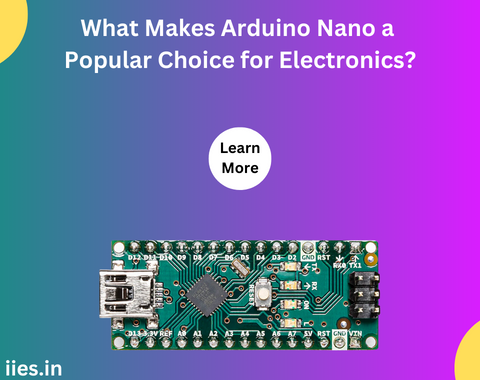
In the ever-evolving world of electronics, the Arduino Nano has emerged as a popular and versatile choice for enthusiasts, hobbyists, and professionals alike. Its compact size, robust functionality, and ease of use make it a go-to option for a wide range of electronic projects. In this article, we will delve into the factors that contribute to the Arduino Nano’s popularity and explore why it has become a preferred platform for electronic enthusiasts.
One of the defining features of the Arduino Nano is its compact size. Measuring just 45mm x 18mm, it is significantly smaller than its predecessors, making it an ideal choice for projects with limited space. The small form factor allows developers to integrate the Arduino Nano seamlessly into various devices without sacrificing valuable real estate. This compact size has contributed to its popularity in applications such as wearables, drones, and embedded systems.
Arduino Nano is not only powerful but also cost-effective. Its affordability makes it accessible to a broad audience, including students, hobbyists, and professionals working on tight budgets. The open-source nature of Arduino also plays a crucial role in its accessibility. The availability of schematics, documentation, and a vast community of users contributes to a wealth of shared knowledge, making it easier for beginners to get started and experts to collaborate on complex projects.
Versatility and Compatibility:
The Arduino Nano is equipped with a microcontroller that provides a myriad of input and output pins, allowing users to connect a variety of sensors, actuators, and other peripherals. Its compatibility with a wide range of shields and modules enhances its versatility, enabling users to expand their projects effortlessly. Whether you are working on a robotics project, home automation, or creating an interactive art installation, the Arduino Nano’s compatibility with a plethora of components makes it a versatile choice.
Ease of Programming:
Arduino Nano is programmed using the Arduino IDE, a user-friendly integrated development environment that simplifies the coding process. Its programming language is based on Wiring, making it accessible even to those with limited programming experience. The Arduino community actively contributes to a vast library of code snippets and examples, allowing users to leverage pre-existing solutions for common tasks. This ease of programming is a significant factor in the Arduino Nano’s popularity, attracting beginners and experts alike.
Integrated USB Connectivity:
The Arduino Nano comes with built-in USB connectivity, allowing users to program and power the board through a USB connection. This eliminates the need for an external programmer, streamlining the development process. The onboard USB-to-serial converter simplifies communication between the computer and the Arduino Nano, making it easy to upload code and debug projects. The integrated USB connectivity enhances the overall user experience and contributes to the board’s widespread adoption.
Community Support and Documentation:
The Arduino Nano has benefited significantly from its robust community support. The Arduino forums, online tutorials, and extensive documentation provide a wealth of resources for both beginners and experienced developers. Users can find solutions to common issues, share their projects, and seek guidance from the community. This collaborative environment fosters learning and innovation, reinforcing the Arduino Nano’s reputation as a reliable and well-supported platform.
Open-Source Philosophy:
Arduino Nano, like other Arduino boards, follows an open-source philosophy. This means that the hardware and software specifications are freely available to the public. The open-source nature encourages collaboration, allowing developers to modify and customize the board to suit their specific needs. This openness has led to the creation of various derivatives and clones, further expanding the options available to users. The collaborative nature of the Arduino ecosystem contributes to the continuous improvement and evolution of the platform.
Low Power Consumption:
Arduino Nano is designed with low power consumption in mind, making it suitable for battery-powered projects. The board’s ability to operate efficiently in low-power modes allows developers to create energy-efficient solutions for applications such as remote sensors, IoT devices, and portable gadgets. This characteristic enhances the Arduino Nano’s appeal for projects where power efficiency is a critical consideration.
Educational Value:
The Arduino Nano’s popularity extends to educational settings, where it serves as an excellent learning tool. Its simplicity, coupled with the wealth of educational resources available, makes it an ideal platform for introducing students to the principles of electronics and programming. Educational institutions often choose Arduino Nano for hands-on projects, fostering a practical understanding of concepts such as coding, circuit design, and interfacing with sensors.
Rapid Prototyping:
Arduino Nano facilitates rapid prototyping, allowing developers to quickly iterate and test their ideas. The combination of a compact form factor, easy-to-use programming environment, and a variety of available shields accelerates the prototyping process. This feature is particularly valuable for engineers and designers working on projects that require quick proof of concept or iterative development cycles.
In conclusion, the Arduino Nano has earned its popularity in the world of electronics due to a combination of factors. Its compact size, affordability, versatility, ease of programming, integrated USB connectivity, strong community support, and open-source philosophy collectively make it an attractive choice for electronic enthusiasts. Whether you are a student diving into the world of electronics, a hobbyist working on a creative project, or a professional developing a commercial product, the Arduino Nano provides a solid foundation for innovation and experimentation in the ever-expanding field of electronics.
Indian Institute of Embedded Systems – IIES